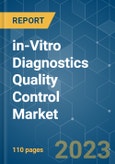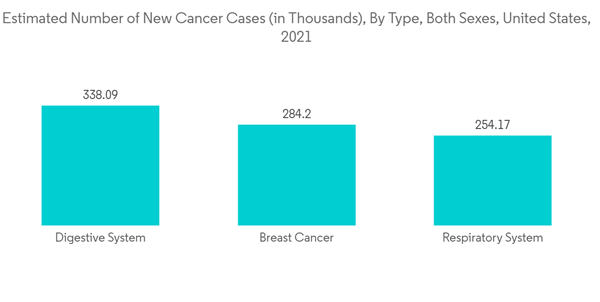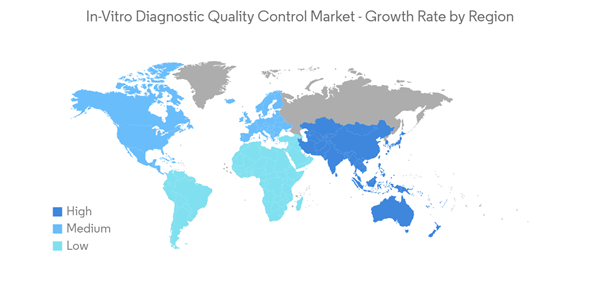The in-vitro diagnostics (IVD) quality control market studied is expected to register a CAGR of 3.5% during the forecast period.
COVID-19 has significantly impacted the growth of the studied market. Due to the spread of the coronavirus infection among the population, the demand for in-vitro diagnostic kits and devices for rapid and accurate diagnosis of SARS-CoV-2 virus infection increased. Also, the strict regulatory guidelines for reducing the spread of COVID-19 and conducting effective testing increased the need and demand for stringent quality controls of testing kits and devices. This has impacted the market growth during the forecast period.
Certain factors attributing to the market growth are the increasing demand for advanced diagnostics for sensitive reports and accurate diagnosis of chronic and infectious diseases and genetic disorders, the growing volume of accredited clinical laboratories, and the adoption of third-party quality controls.
The increasing incidences of chronic, infectious, and genetic diseases across the globe is the key factor driving the market growth. For instance, as per 2022 statistics published by IDF, it has been observed that 74.1 million people were suffering from diabetes in 2021 in India. This number is estimated to reach 92.9 million and 124.8 million by 2030 and 2045, respectively. Thus, the rising burden of diabetes among the population is expected to increase the demand for conducting in-vitro assays for detecting blood glucose. This is anticipated to propel the demand for effective in-vitro diagnostics, thus propelling the need for strict quality control.
Also, as per the data published by the GLOBOCAN 2020 report, it has been observed that breast cancer was the most prevalent form of cancer worldwide in 2020. About 2,261,419 new breast cancer cases were diagnosed in 2020, and this number is expected to increase to 3,025,471 by 2040. Thus, the rising burden of cancer raises the need to detect cancer early for more effective and timely treatment, which increases the demand for in-vitro diagnostics devices and kits, which is anticipated to boost the need for strict quality control of in-vitro diagnostics devices to reduce the chances of false results, which is expected to augment the market growth over the forecast period.
Furthermore, according to an article published by Frontiers in Medicine in May 2022, it has been observed that automated blood culture systems have improved microbiological diagnostic performance, reduced turnaround times, and enhanced yield as compared to manual blood cultures. Thus, the increasing usage of quality-assured advanced blood culture devices and instruments for detecting bloodstream infections is expected to propel the market growth over the forecast period.
Moreover, the rising company activities in developing technologically advanced diagnostic products and increasing product launches contribute to market growth. For instance, in June 2021, Thermo Fisher Scientific Inc. launched TaqPath, a new CE-IVD-marked fast PCR combo kit 2.0, to detect active SARS-CoV-2 infection.
However, unfavorable reimbursement policies for the IVD industry and a lack of stringent regulations for clinical laboratory accreditation in several emerging economies are some of the factors impeding the market growth over the forecast period.
The advancement of precision medicine has provided specific strategies for targeted therapies and medicines for patients with cancer and Mendelian diseases, which prove to be better than traditional clinical practices, increasing the demand for next-generation sequencing, which is also expected to propel the segment growth. For instance, according to the data published by the CDC in January 2021, it is projected that more than 60 million people are likely to have their genomes sequenced by 2025 worldwide.
The COVID-19 pandemic impacted segment growth significantly. During the pandemic, molecular diagnostic tests were adopted by researchers worldwide. For instance, according to a press release published in September 2021, Italian researchers used the Logix Smart COVID-19 Test Kit to confirm the presence of SARS-CoV-2, including mutated strains of the virus, in community surveillance. Thus, the adoption of molecular diagnostics increased during the pandemic, which is further expected to fuel segment growth over the forecast period.
Furthermore, the increasing company focus on developing technologically advanced products in molecular diagnostics and rising new product launches contributes to market growth. For instance, in October 2021, ELITechGroup, an Italy-based company focused on manufacturing and distributing diagnostic solutions to laboratories, launched ELITe BeGenius, a new CE-IVD stand-alone ‘Sample-to-Result’ real-time (RT) PCR solution. The product makes molecular biology universally accessible with a compact footprint, ease of use, and total automation. The company also offers ELITe InGenius and ELITe BeGenius molecular diagnostics instruments to every lab.
Similarly, in June 2021, Thermo Fisher Scientific Inc. launched TaqPath, a new CE-IVD-marked fast PCR combo kit 2.0, to detect active SARS-CoV-2 infection. Such developments are expected to contribute to segment growth over the forecast period.
Therefore, owing to the abovementioned factors, the segment is anticipated to witness growth over the forecast period.
In addition, the high healthcare expenditures in the region are creating opportunities and rising company focus on developing technologically advanced in-vitro diagnostic devices, which are expected to increase the market growth. For instance, according to the OECD data published in June 2022, United States healthcare spending in 2021 was 17.8% of the country's total GDP.
Furthermore, the growing burden of chronic, infectious diseases and genetic disorders is the key factor driving the demand for in-vitro diagnostic tests, propelling the need for effective diagnostic instruments and devices, thereby propelling the market growth. For instance, according to 2022 statistics published by IDF, about 2.9 million people were living with diabetes in Canada in 2021. In addition, as per the same source, this number is projected to reach 3.2 million and 3.4 million by 2030 and 2045, respectively.
Also, per the 2022 statistics published by the Canadian Cancer Society, about 28,600 Canadian women are expected to be diagnosed with breast cancer in 2022, representing 25% of all new cancer cases in women in 2022. The high number of breast cancer cases among the population is expected to increase the demand for effective diagnostic tests, which is anticipated to propel the demand for in-vitro diagnostic devices and kits. Thus, with the rising demand for diagnostic kits and devices, the need for quality control also increases, which is expected to augment the market growth over the forecast period.
Moreover, the increasing product launches in the region are also expected to increase the need for strict and comprehensive quality control of diagnostic devices to provide accurate test results, which are anticipated to fuel the market growth in the region. For instance, in April 2022, Bruker Corporation announced further to advance its market-leading MALDI Biotyper (MBT) platform and launch new multiplex PCR infectious disease assays based on its proprietary LiquidArray technology. In a single test, the FluoroType Mycobacteria PCT test uses sophisticated LiquidArray technology to distinguish 31 clinically important non-tuberculous mycobacteria and the Mycobacterium tuberculosis complex from cultures. Also, in October 2021, ThermoFisher Scientific launched Applied Biosystem QuantSudio Absolute Q-Digital PCR System, designed to provide highly accurate results in genetic analysis. Digital PCR is already in use for monitoring cancer-driven mutations in liquid biopsy. This has helped the company to increase its product portfolio. Therefore, owing to the abovementioned factors, the segment is anticipated to witness growth over the forecast period.
This product will be delivered within 2 business days.
COVID-19 has significantly impacted the growth of the studied market. Due to the spread of the coronavirus infection among the population, the demand for in-vitro diagnostic kits and devices for rapid and accurate diagnosis of SARS-CoV-2 virus infection increased. Also, the strict regulatory guidelines for reducing the spread of COVID-19 and conducting effective testing increased the need and demand for stringent quality controls of testing kits and devices. This has impacted the market growth during the forecast period.
Certain factors attributing to the market growth are the increasing demand for advanced diagnostics for sensitive reports and accurate diagnosis of chronic and infectious diseases and genetic disorders, the growing volume of accredited clinical laboratories, and the adoption of third-party quality controls.
The increasing incidences of chronic, infectious, and genetic diseases across the globe is the key factor driving the market growth. For instance, as per 2022 statistics published by IDF, it has been observed that 74.1 million people were suffering from diabetes in 2021 in India. This number is estimated to reach 92.9 million and 124.8 million by 2030 and 2045, respectively. Thus, the rising burden of diabetes among the population is expected to increase the demand for conducting in-vitro assays for detecting blood glucose. This is anticipated to propel the demand for effective in-vitro diagnostics, thus propelling the need for strict quality control.
Also, as per the data published by the GLOBOCAN 2020 report, it has been observed that breast cancer was the most prevalent form of cancer worldwide in 2020. About 2,261,419 new breast cancer cases were diagnosed in 2020, and this number is expected to increase to 3,025,471 by 2040. Thus, the rising burden of cancer raises the need to detect cancer early for more effective and timely treatment, which increases the demand for in-vitro diagnostics devices and kits, which is anticipated to boost the need for strict quality control of in-vitro diagnostics devices to reduce the chances of false results, which is expected to augment the market growth over the forecast period.
Furthermore, according to an article published by Frontiers in Medicine in May 2022, it has been observed that automated blood culture systems have improved microbiological diagnostic performance, reduced turnaround times, and enhanced yield as compared to manual blood cultures. Thus, the increasing usage of quality-assured advanced blood culture devices and instruments for detecting bloodstream infections is expected to propel the market growth over the forecast period.
Moreover, the rising company activities in developing technologically advanced diagnostic products and increasing product launches contribute to market growth. For instance, in June 2021, Thermo Fisher Scientific Inc. launched TaqPath, a new CE-IVD-marked fast PCR combo kit 2.0, to detect active SARS-CoV-2 infection.
However, unfavorable reimbursement policies for the IVD industry and a lack of stringent regulations for clinical laboratory accreditation in several emerging economies are some of the factors impeding the market growth over the forecast period.
In Vitro Diagnostics Quality Control Market Trends
Molecular Diagnostics Segment Expects to Register a High CAGR in the In-Vitro Diagnostics Quality Control Market Over the Forecast Period
Molecular diagnostic devices are used to analyze biological markers in the genome and proteome to detect pathogens or mutations. Based on the technology, molecular diagnostic devices can be segmented into chips and microarrays, mass spectroscopy, next-generation sequencing (NGS), polymerase chain reaction (PCR)-based methods, cytogenetics, and molecular imaging. Factors such as large outbreaks of bacterial and viral epidemics, increasing demand for point-of-care diagnostics, and rapidly evolving technology are driving the growth of the molecular diagnostics segment.The advancement of precision medicine has provided specific strategies for targeted therapies and medicines for patients with cancer and Mendelian diseases, which prove to be better than traditional clinical practices, increasing the demand for next-generation sequencing, which is also expected to propel the segment growth. For instance, according to the data published by the CDC in January 2021, it is projected that more than 60 million people are likely to have their genomes sequenced by 2025 worldwide.
The COVID-19 pandemic impacted segment growth significantly. During the pandemic, molecular diagnostic tests were adopted by researchers worldwide. For instance, according to a press release published in September 2021, Italian researchers used the Logix Smart COVID-19 Test Kit to confirm the presence of SARS-CoV-2, including mutated strains of the virus, in community surveillance. Thus, the adoption of molecular diagnostics increased during the pandemic, which is further expected to fuel segment growth over the forecast period.
Furthermore, the increasing company focus on developing technologically advanced products in molecular diagnostics and rising new product launches contributes to market growth. For instance, in October 2021, ELITechGroup, an Italy-based company focused on manufacturing and distributing diagnostic solutions to laboratories, launched ELITe BeGenius, a new CE-IVD stand-alone ‘Sample-to-Result’ real-time (RT) PCR solution. The product makes molecular biology universally accessible with a compact footprint, ease of use, and total automation. The company also offers ELITe InGenius and ELITe BeGenius molecular diagnostics instruments to every lab.
Similarly, in June 2021, Thermo Fisher Scientific Inc. launched TaqPath, a new CE-IVD-marked fast PCR combo kit 2.0, to detect active SARS-CoV-2 infection. Such developments are expected to contribute to segment growth over the forecast period.
Therefore, owing to the abovementioned factors, the segment is anticipated to witness growth over the forecast period.
North America Dominates the In-Vito Diagnostics Quality Control Market and Expects to do Same in the Forecast Period.
North America is expected to witness significant growth in the in-vitro diagnostics quality control market over the forecast period. The factors attributing to the market growth are the rising incidences and prevalence of chronic and infectious diseases, genetic disorders, rising technological advancements, and a growing number of regional diagnostic labs.In addition, the high healthcare expenditures in the region are creating opportunities and rising company focus on developing technologically advanced in-vitro diagnostic devices, which are expected to increase the market growth. For instance, according to the OECD data published in June 2022, United States healthcare spending in 2021 was 17.8% of the country's total GDP.
Furthermore, the growing burden of chronic, infectious diseases and genetic disorders is the key factor driving the demand for in-vitro diagnostic tests, propelling the need for effective diagnostic instruments and devices, thereby propelling the market growth. For instance, according to 2022 statistics published by IDF, about 2.9 million people were living with diabetes in Canada in 2021. In addition, as per the same source, this number is projected to reach 3.2 million and 3.4 million by 2030 and 2045, respectively.
Also, per the 2022 statistics published by the Canadian Cancer Society, about 28,600 Canadian women are expected to be diagnosed with breast cancer in 2022, representing 25% of all new cancer cases in women in 2022. The high number of breast cancer cases among the population is expected to increase the demand for effective diagnostic tests, which is anticipated to propel the demand for in-vitro diagnostic devices and kits. Thus, with the rising demand for diagnostic kits and devices, the need for quality control also increases, which is expected to augment the market growth over the forecast period.
Moreover, the increasing product launches in the region are also expected to increase the need for strict and comprehensive quality control of diagnostic devices to provide accurate test results, which are anticipated to fuel the market growth in the region. For instance, in April 2022, Bruker Corporation announced further to advance its market-leading MALDI Biotyper (MBT) platform and launch new multiplex PCR infectious disease assays based on its proprietary LiquidArray technology. In a single test, the FluoroType Mycobacteria PCT test uses sophisticated LiquidArray technology to distinguish 31 clinically important non-tuberculous mycobacteria and the Mycobacterium tuberculosis complex from cultures. Also, in October 2021, ThermoFisher Scientific launched Applied Biosystem QuantSudio Absolute Q-Digital PCR System, designed to provide highly accurate results in genetic analysis. Digital PCR is already in use for monitoring cancer-driven mutations in liquid biopsy. This has helped the company to increase its product portfolio. Therefore, owing to the abovementioned factors, the segment is anticipated to witness growth over the forecast period.
In Vitro Diagnostics Quality Control Market Competitor Analysis
The in-vitro diagnostics quality controls market is moderately competitive and consists of several major players. Some companies are expanding their market position by adopting various strategies such as acquisitions and mergers, while others are developing new methods for treatment and introducing new products to maintain their market share. Bio-Rad Laboratories Inc., F. Hoffmann-La Roche AG, SeraCare Life Sciences Inc., bioMerieux Inc., and ZeptoMetrix Corporation are some of the companies currently dominating the market.Additional benefits of purchasing the report:
- The market estimate (ME) sheet in Excel format
- 3 months of analyst support
This product will be delivered within 2 business days.
Table of Contents
1 INTRODUCTION
4 MARKET DYNAMICS
5 MARKET SEGMENTATION (Market Size by Value - USD million)
6 COMPETITIVE LANDSCAPE
Companies Mentioned (Partial List)
A selection of companies mentioned in this report includes, but is not limited to:
- Abbott Laboratories
- Bio-Rad Laboratories Inc.
- F. Hoffmann-La Roche AG
- Quidel Corporation
- bioMerieux Inc.
- Qnostics Ltd
- Microbiologics Inc.
- SeraCare Life Sciences Inc.
- Thermo Fisher Scientific
- ZeptoMetrix Corporation
Methodology

LOADING...










